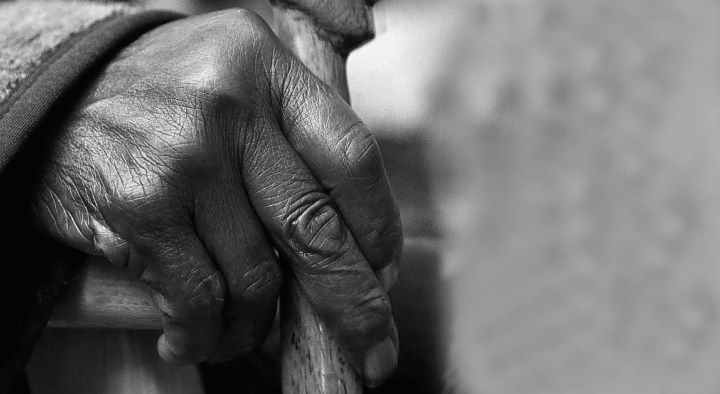SPOTLIGHT
Digital conference shines light on ageing with HIV

HIV and ageing was one of the hot topics at the virtual Conference on Retroviruses and Opportunistic Infections held between 12 and 24 February 2022.
In the opening session of the conference, Marc Thompson, an older person living with HIV in the United Kingdom, addressed the topic of ageing with HIV from first-hand experience. He highlighted eight points related to ageing with HIV. We outline them and ask two local experts how the issues play out in South Africa.
- The impact of HIV on ageing
Thompson highlighted that not enough is known about the impact of HIV on ageing, nor the impact of ageing on HIV.
Dr Michelle Moorhouse, senior global medical director at the pharmaceutical company ViiV Healthcare, says that about 18 to 20% of people living with HIV in South Africa are considered to be part of the ageing population, which translates to around 1.3 to 1.4 million people.
She says older people living with HIV have higher levels of inflammation than younger people living with the disease and people without HIV, even when their virus is suppressed by antiretroviral therapy (ARVs). But their inflammation levels are lower than those not on ART.
“The earlier treatment is started, the lower those levels of inflammation, which reduces the risk of developing comorbidities. ART also reduces the risk of developing HIV-related complications, opportunistic infections, and HIV-related cancers,” she says.
She adds that ARVs do have potential long-term toxicities, which vary across classes of ARVs, with more modern ARVs being better tolerated and less toxic over the long term than older ARVs.
Moorhouse says that studies on ARVs have recently started reporting outcomes stratified by age groups, but the number of older persons in many studies remains low.
“It is important to ensure that more older people living with HIV are included in such studies, given that the proportion of people living with HIV who are 50 years or older is increasing globally,” she says.
In addition to this, many large cohorts of older people living with HIV are being followed over time in high-income countries (HICs), providing a lot of data related to ageing with HIV, according to Moorhouse. Yet, despite around 70% of older people living with HIV residing in low- and middle-income countries (LMICs), there are very few similar cohorts being studied in these countries.
- Threats to continuity of care
Because of the success of antiviral therapy, HIV care has changed for many individuals and for some has resulted in a move from specialist care to general practice, which is not always equipped to deal with the issues of care connected to HIV, says Thompson.
“We should be working alongside colleagues across other conditions and disciplines to look at how we might integrate different systems of care,” he says.
Moorhouse says that the opposite has been observed in some LMICs. She explains that in South Africa and several other Sub-Saharan countries, studies have found that older people living with HIV who are stable and virally suppressed on ART may have better outcomes with comorbidities than their peers without HIV.
“This is most likely driven by the fact that massive investment into HIV programmes across Sub-Saharan Africa means that people living with HIV have better healthcare access than their HIV-negative counterparts,” she says.
Prof Kathleen Kahn, a researcher based in the School of Public Health at the University of Witwatersrand spoke to Spotlight about just such a trend in a research project she is involved with, called the Health and Aging in Africa: Longitudinal Studies in three in-depth communities (HAALSI). They found that individuals living with HIV in their study cohort based in Mpumalanga who have a comorbidity, for example hypertension, received better care than individuals who only had hypertension.
- Experiencing comorbidity and several non-HIV-related conditions
Ageing comes with an increased risk of developing comorbidities, yet the impact that HIV has on non-HIV conditions, for example cardiovascular disease and diabetes, is not well understood, according to Thompson.
“For us, the patient, we now have to deal with the challenges of managing care with multiple doctors and other providers. This challenge raises the need for case management services that can help facilitate all of these diverse and medical care needs that we will have,” he says.
Moorhouse explains that older people living with HIV are at risk of developing many of the same age-related complications as people without HIV. This includes cardiovascular disease like diseases of the heart and blood vessels, high blood pressure, heart attacks, stroke, type 2 diabetes, kidney disease, liver disease, osteoporosis, certain cancers like lung cancer, Hodgkin’s lymphoma, liver and anal cancer, and geriatric syndromes like frailty and decreased physical functioning.
The difference is that they are likely to develop these earlier than their peers who do not have HIV.
She adds that older persons living with HIV who were only recently diagnosed often have advanced HIV disease, putting them at higher risk of developing HIV-related opportunistic infections and cancers than people living with HIV who are stable on ART.
“Older persons living with HIV newly starting ART are at increased risk not only of HIV-related opportunistic infections and cancers but also of age-related complications,” she says.
- Issues around polypharmacy
Comorbidities lead to the use of more medications. According to Thompson, many older people living with HIV are treatment smart, but it is unclear how adding more medications due to comorbidities will affect the individual and how HIV medication will interact with non-HIV medication.
Moorhouse says that polypharmacy is an issue at any age, as people living with HIV are more likely to be taking more non-ARV medications than people without HIV.
“But for older people living with HIV, this is an even bigger problem and often the additional medications may be prescribed by a different healthcare provider and so they may not be aware of the HIV status nor of the ART regimen,” she says.
The same is true of healthcare providers treating HIV who may not be aware of the treatment being used for other conditions. This puts older persons living with HIV at increased risk of drug interactions, which may affect virological control and lead to potentially developing resistance to ARVs and/or poorly controlled comorbidities.
“Integrated care does help to mitigate this to some extent, if one healthcare professional is providing primary care, including screening for and managing these conditions,” she says.
- Increased need for support services
Thompson says that older people living with HIV have increased physical, emotional, and social needs that should be addressed.
“It’s time to rethink the need for the provision of community-based services for older people living with HIV. And then, how do we link those with generic services that we will be accessing,” he says.
Low-to-middle-income countries like South Africa, on the other hand, are facing a different set of challenges.
One big issue is that healthcare services in South Africa are dealing with an increased burden as older persons living with HIV are presenting with multiple conditions or comorbidities at a much younger age than in high-income countries, says Kahn.
“That is because we are seeing this coexistence of chronic infectious conditions like HIV, which start in younger adulthood with the non-communicable conditions like hypertension and diabetes, which generally start at older ages. But because of HIV, we’re seeing these multimorbidities commencing at younger ages,” she says.
Moorhouse explains that there could be a difference between the process of ageing and development in older persons living with HIV in South Africa versus high-income countries. She adds that rates of late diagnosis and advanced HIV are also much higher in LMICs. There are also differences in ART regimens, with LMICs having limited scope to tailor ART regimens according to potential risk factors, side effects, or suitability for the individual.
“The social determinants of health differ between South Africa and HICs and often impact older people, with or without HIV, disproportionately,” Moorhouse adds.
- Persistent loneliness and isolation
“We have enough evidence, both anecdotal and empirical, that people with HIV already experience loneliness and isolation. In a world where old age renders you invisible, this will only increase,” Thompson says.
“One of the most difficult challenges older persons living with HIV face is social isolation, which impacts their mental health and wellbeing. And they face enormous stigma, related to their HIV and also to their age,” says Moorhouse. “Stigma has a biological impact too, including being a driver of inflammation.”
- Heightened concerns about stigma and discrimination
From the perspective of the UK, Thompson says, “As we become more isolated, moving to care that is not HIV-specific, our carers, even those with the best intentions, don’t understand or care about our HIV experience and journey.” He adds that fighting HIV stigma is not a one-size-fits-all. There needs to be an intersectional response that looks at HIV through the lens of race, gender, sexuality, and age.
According to Kahn, one of the trends their research in South Africa picked up is that older people remain sexually active well into old age and have the same sexual risk factors as younger people for acquiring and transmitting HIV.
“This was perhaps not well recognised before and is highly stigmatised amongst older adults,” she says.
Kahn says there are a lot of campaigns and HIV prevention programmes targeted at young people around the behavioural risk for HIV acquisition, but the same is not available to older people.
- Quality of life and ageing well
Thompson says that older people living with HIV want to age well with a good quality of life.
“It’s not enough for us just to be grateful that we are still here… We want to have good quality of life and to age well. After decades of surviving, we want to continue to survive but we also want to thrive,” he says.
Moorhouse says there is no simple or short answer when it comes to mitigating the burden faced by older people living with HIV in South Africa, but highlights stigma as one of the main issues to focus on.
“The biggest problem we need to tackle is stigma. We have made massive strides in achieving HIV testing, treatment, and virological suppression targets in SA and globally, but we cannot seem to move the needle on stigma. Because of perceived stigma, older people may not seek HIV testing, delaying diagnosis and resulting in poorer outcomes,” she says. DM/MC
*This article was published by Spotlight – health journalism in the public interest.




















 Become an Insider
Become an Insider
Comments - Please login in order to comment.